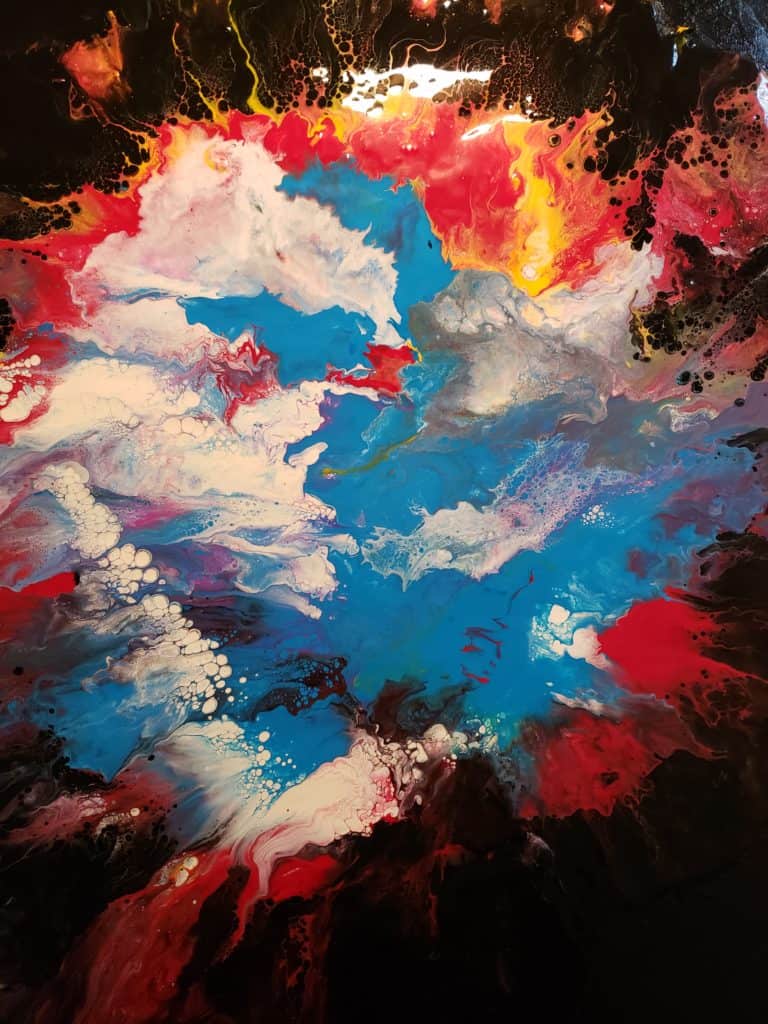I recently had the opportunity to submit a piece to a show; this wasn’t just any show, but my first show EVER! I wrote my artist bio, gathered some supplies, and quarantined myself in my studio the very first moment I could. I was ready to weave some serious artistic magic!
I poured. I scraped. I poured again. I scraped again. I yelled. I swore. By the time the fourth scrape landed in the trash, I was ready to light that cursed canvas on fire and toast marshmallows over it’s sad, frustrating remains.
Instead, I threw every color I had mixed for the project into a cup and dumped it in the middle of the canvas, and then used my blow dryer and more swear words to manipulate it outwards. I turned off the blow dryer and took a step back to look at what I was positive would be a disaster.
That canvas is probably the best piece of artwork I have ever made.

Creation Frustration
This isn’t a story unique to me. I see it in the AP.com Facebook group all the time; muddy colors, frustrating commissions, etc. For me, I find that the most difficult time is when I’m expected to create something; i.e., when I’m creating a show piece, or when someone orders a commission from me. The extra added pressure to deliver and the anxiety over creating perfection using one of the most abstract methods possible means that my commissions and show pieces are never first-try affairs. No, they are layers of scrapes and repours, and the final product is never exactly how I imagined it.
So, what’s to be done with this frustration?
-
Most importantly, don’t give up. If you throw in the towel and rage quit in a moment of artistic “blah”, you won’t learn how to harness that frustration and turn it into art. Instead of giving up, just walk away for a few minutes and grab a cup of coffee or read a few pages of a book. Then, go back to your piece and try again. I’ve found that the pieces I hated at creation aren’t nearly as awful when I look at them with fresh eyes.
-
Understand that becoming frustrated will limit your ability to create. When I get frustrated, I fumble. It’s as if my brain is determined to knock over everything I try to pick up! When you become frustrated, take a few deep breaths and remember that rushing through your processes, cutting corners or hastily creating is not going to solve your problem. Take your time with your process, don’t let frustration make you rush.
Identifying Problem Areas
A lot of creation frustration can come from unexpected issues like cracking, muddy colors or other completely fixable problems.
-
Muddy colors can be avoided. Yes—you may need to scrape your painting to fix this issue, but you probably don’t need to throw away the whole canvas. Muddy colors happen when non-primary colors like orange and green are layered together in a pour. If you plan on using non-primary colors to create a piece, consider the following:
○ Do a quick dirty pour; essentially, layer your colors and then quickly pour them on your canvas before they have had time to combine in the cup. This isn’t a fool proof method, over-manipulating your piece will still produce mud. However, if you don’t manipulate a lot, you should retain separate coloring.
○ Layer black, white, gold or silver between your colors to keep them separated.
In any case, it’s usually best to avoid flip cups if you’re layering non-primary colors without a separator like black or white—flip cups give paint too much room to mingle!
-
Cracking paint is likely too thick. Again, this is another issue that may result in a scraped canvas, but you can solve the issue on the next pour by making sure your paint isn’t in too thick a layer on your canvas. Also, make sure that there isn’t direct air flow on your piece, as this can cause the top layer to dry too quickly and increase your chance of cracks. Some brands of white paint have also been known to crack; I’ve had good luck with Liquitex, Golden, and Nicole’s Craft paints.
-
Paint is too runny. If your paint mixture is too runny, add more paint! Your consistency should be comparable to melted ice cream (not the chunky kind). It should be smooth, well incorporated, and flow without impairment. Paint that is too runny may not hold up well on your canvas; add a bit more paint to thicken up your mixture.
-
Paint is too thick. If your paint mixture is too thick, add a bit more of your medium. I use Floetrol at a mix ratio of two parts Floetrol to one part paint (2:1) for thicker paints like Liquitex Basics. For thinner paints like Golden Fluid Acrylics or Nicole’s Craft paints, I use a 1:1 ratio. Know your paint, know your medium, and experiment with consistencies that work for you. Just remember: melted ice cream, no chunks!
Other Factors
Sometimes, creation frustration stems from the desire to create something you’ve seen in the Facebook Group, or from an artist you respect on YouTube. Although imitation is a great way to learn, it’s not a good idea to try to emulate another artist’s painting exactly. Experiment with the method, yes—but don’t expect to get an identical result. If you do have this expectation, you may be setting yourself up to be disappointed when it doesn’t turn out.
Creation frustration is a difficult thing, but it’s not an insurmountable thing. If you’re having issues with your technique or color combinations, come see us in the Facebook group—we can help!

Sara Wagner is an author and artist from Upstate New York. She is the owner of Studio Blackwater and can typically be found covered in paint, cats, or her two young daughters. You can find her on Facebook and Instagram as @studioblackwater.

Hi,
OMG! I am so stuck on a commission piece.. The canvas itself is 72″ by 48″ yes, it’s hugh. The first pour was the flip cup method. Never having done one so large, I really didn’t know how much paint I would need to cover it. Well needless to say I poured way too much and then some…the paint I tilted off circled around beneath it on ground I couldn’t help but to step in it as I moved from tilting one side to the other Nothing like paint coming up through my toes!
I was leaving on a trip shortly afterwards so I wasn’t able to do much tweaking to its composition. when I returned and saw the dried results… It was just okay. I tried to pour over the original and failed miserably twice. The other factor I’m facing is the canvas now sags a little in the middle from failing to tilt off more of the paint the first time.
And on top of everything else the client has left the colors and type of pouring technique up to me. the one good thing is none of the above has been at the clients expense, financially anyway.
Of course I want the end result to knock their pants off… Any suggestions? I really like what you have done with your gravity technique and wonder if I could leave the canvas slightly tilted so as not to puddle in the middle?
Kindly,
Joy
Hi again,
sorry I was reading a prior article before I saw yours about their repairing a pour with a gravity swipe..
Joy
I think for a canvas that size (which is huge!) it may be a good idea to have something that the framed canvas can rest on to prevent sagging in the middle. I picture a piece of plywood or something that will give the canvas a flat surface underneath while the paint is drying.
Were the marshmallows nice? LOL